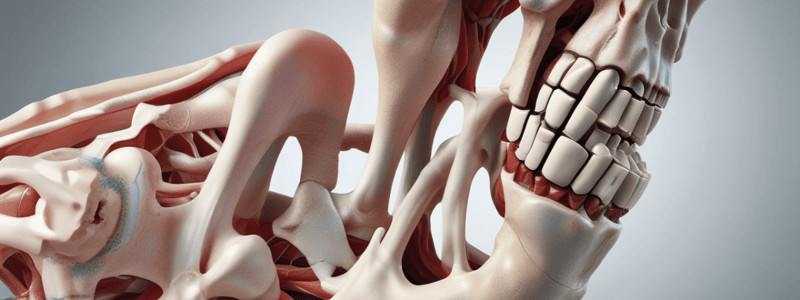Podcast
Questions and Answers
Which of the following structures attaches to the tarsal sinus?
Which of the following structures attaches to the tarsal sinus?
- Dorsal interossei
- Flexor retinaculum
- Inferior extensor retinaculum (correct)
- Plantar aponeurosis
What is the shape of the posterior articular facet on the dorsal surface of the calcaneus?
What is the shape of the posterior articular facet on the dorsal surface of the calcaneus?
- Crescentic
- Oval (correct)
- Rectangular
- Triangular
Which ligament lies within the tarsal canal?
Which ligament lies within the tarsal canal?
- Cervical ligament
- Interosseous talocalcaneal ligament (correct)
- Bifurcate ligament
- Plantar calcaneonavicular ligament
What is the relationship between the calcaneal sulcus and the sulcus tali?
What is the relationship between the calcaneal sulcus and the sulcus tali?
Which of the following is NOT a feature of the dorsal surface of the calcaneus?
Which of the following is NOT a feature of the dorsal surface of the calcaneus?
What is the direction of the tarsal canal?
What is the direction of the tarsal canal?
Which of the following structures attaches to the lateral process (posterolateral tubercle) of the calcaneal tuberosity?
Which of the following structures attaches to the lateral process (posterolateral tubercle) of the calcaneal tuberosity?
Which of the following statements regarding the plantar surface of the calcaneus is incorrect?
Which of the following statements regarding the plantar surface of the calcaneus is incorrect?
Which of the following structures attaches to the area between the lateral and medial processes of the calcaneal tuberosity?
Which of the following structures attaches to the area between the lateral and medial processes of the calcaneal tuberosity?
Which of the following structures does not attach to the medial process (posteromedial tubercle) of the calcaneal tuberosity?
Which of the following structures does not attach to the medial process (posteromedial tubercle) of the calcaneal tuberosity?
The posterior talocalcaneal ligament and calcaneofibular ligament attach to which region of the calcaneus?
The posterior talocalcaneal ligament and calcaneofibular ligament attach to which region of the calcaneus?
Which of the following statements about the dorsal surface of the calcaneus is correct?
Which of the following statements about the dorsal surface of the calcaneus is correct?
Which of the following statements about the lateral surface of the calcaneus is correct?
Which of the following statements about the lateral surface of the calcaneus is correct?
What is the primary function of the fibular trochlea on the lateral surface of the calcaneus?
What is the primary function of the fibular trochlea on the lateral surface of the calcaneus?
Which of the following structures is least likely to be present on the lateral surface of the calcaneus?
Which of the following structures is least likely to be present on the lateral surface of the calcaneus?
What is the primary function of the medial surface of the calcaneus?
What is the primary function of the medial surface of the calcaneus?
Which of the following structures is most likely to be present on the lateral surface of the calcaneus?
Which of the following structures is most likely to be present on the lateral surface of the calcaneus?
Which of the following ligaments attaches to the lateral surface of the calcaneus?
Which of the following ligaments attaches to the lateral surface of the calcaneus?
Study Notes
Tarsal Structures and Facets
- The tarsal sinus is associated with the interosseous talocalcaneal ligament.
- The posterior articular facet on the dorsal surface of the calcaneus is oval-shaped.
- The tarsal canal contains the fibrous sheath of the tendon of the flexor hallucis longus.
Relationship of Sulci
- The calcaneal sulcus runs parallel to the sulcus tali, forming a groove for the interosseous talocalcaneal ligament.
Features of Calcaneus
- Features NOT present on the dorsal surface of the calcaneus include the fibular trochlea.
- The tarsal canal runs obliquely from posterior to anterior and medial to lateral.
Attachments on Calcaneal Tuberosity
- The lateral process (posterolateral tubercle) of the calcaneal tuberosity serves as an attachment for the lateral collateral ligaments.
- Structures attaching between the lateral and medial processes of the calcaneal tuberosity include the plantar aponeurosis.
- Structures that do not attach to the medial process (posteromedial tubercle) include the long plantar ligament.
Ligaments and Surfaces
- The posterior talocalcaneal ligament and calcaneofibular ligament attach to the lateral surface of the calcaneus.
- The dorsal surface of the calcaneus is characterized by a prominent calcaneal tuberosity and a smooth area for joint articulation.
- The lateral surface of the calcaneus is notable for the presence of the fibular trochlea.
Functional Aspects
- The primary function of the fibular trochlea on the lateral surface is to guide the fibularis longus and brevis tendons.
- Structures least likely to be present on the lateral surface include the flexor hallucis longus tendon.
- The primary function of the medial surface of the calcaneus is to provide support and stability to the foot's arch.
- The most commonly present structure on the lateral surface is the peroneal tubercle.
- Ligaments that attach to the lateral surface of the calcaneus include the anterior talofibular ligament and calcaneofibular ligament.
Studying That Suits You
Use AI to generate personalized quizzes and flashcards to suit your learning preferences.
Related Documents
Description
Test your knowledge on the anatomy of the lateral surface of the calcaneus bone. Learn about the retrotrochlear eminence and other landmarks on this bony structure.



